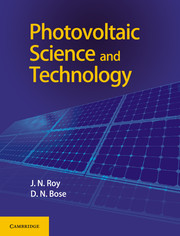Book contents
- Frontmatter
- Dedcation
- Contents
- Figures
- Tables
- Preface
- Acknowledgments
- 1 Introduction to Solar Energy and Solar Photovoltaics
- 2 Crystalline Silicon Cells
- 3 Thin Film Solar Cells
- 4 III-V Compound, Concentrator and Photoelectrochemical Cells
- 5 Organic and Polymer Solar Cells
- 6 Manufacture of c-Si and III-V-based High Efficiency Solar PV Cells
- 7 Manufacture of Solar PV Modules
- 8 Characterization, Testing and Reliability of Solar PV Module
- 9 Overview of Solar PV System Technology and Design
- 10 Design and Implementation of Off-Grid and On-Grid SPV Systems
- Index
- References
10 - Design and Implementation of Off-Grid and On-Grid SPV Systems
Published online by Cambridge University Press: 05 July 2018
- Frontmatter
- Dedcation
- Contents
- Figures
- Tables
- Preface
- Acknowledgments
- 1 Introduction to Solar Energy and Solar Photovoltaics
- 2 Crystalline Silicon Cells
- 3 Thin Film Solar Cells
- 4 III-V Compound, Concentrator and Photoelectrochemical Cells
- 5 Organic and Polymer Solar Cells
- 6 Manufacture of c-Si and III-V-based High Efficiency Solar PV Cells
- 7 Manufacture of Solar PV Modules
- 8 Characterization, Testing and Reliability of Solar PV Module
- 9 Overview of Solar PV System Technology and Design
- 10 Design and Implementation of Off-Grid and On-Grid SPV Systems
- Index
- References
Summary
INTRODUCTION
An overview of the Solar Photovoltaic (SPV) systems has been presented in Chapter 9. The entire system [1–9] consists of: (a) solar field; (b) structure; (c) Balance of System (BOS) comprising DC-DC converter, Maximum Power Point Tracking (MPPT), inverter/ Power Conditioning Unit (PCU) and other accessories such as LT panel, cables, combiner box, connectors, etc.; (d) storage, if required, comprising battery and charge controller and (e) transformer for on-grid systems. A solar field provides a varying DC output decided primarily by insolation and ambient conditions. The design and implementation of the solar fields consisting of solar modules connected in series and parallel, known as ‘string and array design’, has been discussed in some detail in Chapter 9. Structures are required to mount the modules. The structure for a fixed system is relatively simple. Tracking structures are more complex as these require provision for movement of the modules according to the Sun's position. Motors with movable structures are, therefore, required for such installations. The movement of the motor can be programmed to ensure that the Sun's rays fall perpendicular to the module face whenever possible. Dual axis tracking is even more complex than single axis tracking. It may be noted that the power required for driving the motors are provided from the power generated from the SPV plant.
The DC-DC converter along with MPPT takes the output of the solar field as an input and converts this to a maximum possible stable DC output. In case storage is provided, a battery is required to store some amount of energy for later use. A charge controller is also required to manage the charging and discharging of the battery. The inverter provides the AC output to the corresponding loads. A solar inverter consists of DC-DC with MPPT control and DC-AC converters. A Power Conditioning Unit (PCU) is essentially a solar inverter along with a charge controller. Accessories, such as cables, connectors, combiner box, LT panel, etc., are required to implement the string and array design (DC side) and manage the interface between inverter/PCU output and load (AC side). An on-grid system, which is also known as ‘SPV power plant’, sends the generated power to the electricity grid local substation.
- Type
- Chapter
- Information
- Photovoltaic Science and Technology , pp. 358 - 400Publisher: Cambridge University PressPrint publication year: 2017

